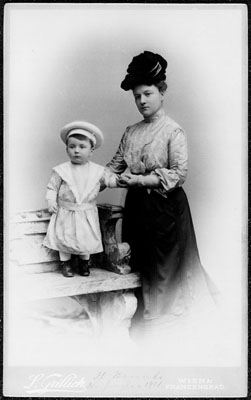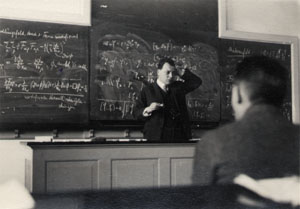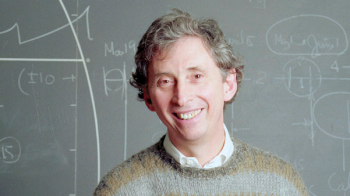This year marks the 100th anniversary of Wolfgang Pauli, who was born in Vienna on 25 April 1900 and died in Zürich on 15 December 1958. Maurice Jacob describes several events that have been arranged to mark the Pauli centenary.

Wolfgang Pauli – long the “conscience of physics” – was professor at ETH-Zürich for 30 years, from 1928 to 1958, except during the Second World War, when he was at Princeton at the Institute for Advanced Study. To honour his centenary, the ETH Library organized a special exhibition, which was first presented at ETH Zürich in April and May.
The exhibition, which beautifully illustrates Pauli’s life, has now moved to CERN where it is on display in the Main Building from 17 August until 26 September. A ceremony in the Council Chamber on Monday 11 September at 4.30 p.m. will include short presentations from Maurice Jacob (chairman of the Pauli Committee), Konrad Osterwalder (Rektor of the ETHZürich), Luciano Maiani (director-general of CERN) and Charles Enz (University of Geneva) on Pauli’s life and legacy.
It is natural that CERN honours in this way one of the greatest physicists of the past century. Pauli acted as custodian of intellectual integrity while the field underwent tremendous development. He discovered the Exclusion Principle, which he formulated in 1924 and for which he was awarded the Nobel prize in 1945. He predicted the existence of the neutrino in 1930. However, he first became known through the publication of his famous 1921 review on relativity, when he was a student of Arnold Sommerfeld’s. Many physicists, including Einstein, much admired this article, later reprinted as a book.
After the centenary exhibition, the next Pauli milestone will be the publication of the authoritative biography by Charles Enz. This should be complete in 2002, “in phase” with the completion of the Herculean task of publishing Pauli’s scientific correspondence.
Pauli and CERN

Wolfgang Pauli left an imposing scientific correspondence. At a time when private correspondence, rather than preprints and e-mail, was instrumental in discussing and maturing ideas, his advice was often solicited and given on many key issues. Pauli maintained a prolific correspondence with the greatest physics minds of his time – Einstein, Bohr, Heisenberg and many others – amounting to several thousand letters.
This correspondence is a mine of information on the development of theoretical physics and is of great value both to physicists interested in history and to historians interested in modern physics. Most of the letters deal with topical physics questions, but they also reflect Pauli’s great interest in philosophy and psychology.
After her husband’s death, Mrs Franca Pauli, helped by Charles Enz, Pauli’s last scientific assistant, began to sort out and administer this scientific legacy and invited friends and colleagues of Pauli to send copies of scientific correspondence. Mrs Pauli relied on the advice and help of Victor Weisskopf, who had been one of Pauli’s first assistants at ETH Zürich and was soon to become director-general of CERN.
In August 1960 Mrs Pauli made a first deed of gift to CERN on behalf of her late husband’s estate. After Mrs Pauli’s death in July 1987, all author rights as well as inherent legal financial claims from the scientific work of Pauli were transferred to CERN. A second formal deed of gift was made in November 1971.
Thus, while CERN has the privilege of being the home of the Pauli Archive – scientific books, reprints, correspondence, manuscripts and photographs, as well as his Nobel Prize and other awards – it also has copyright on all hitherto unpublished works of Pauli and had to assume responsibility for publishing the scientific correspondence. CERN signed a contract with Springer-Verlag for the publication of this correspondence.
The Pauli Committee
After Weisskopf’s mandate as CERN director-general (1961-1965), the responsibility for the Pauli Archive was assigned to a committee chaired by the new director-general, Bernard Gregory. Responsibility for looking after the collection passed to CERN’s Scientific Information Service (including the CERN library).
Weisskopf remained a member of the Pauli Committee, chaired by successive director-generals, until Leon Van Hove was mandated by Herwig Schopper to retain chairmanship of the committee after Van Hove left his director-general position in 1981. I succeeded Van Hove as chairman when he retired from CERN in 1989. My successor is Gabriele Veneziano.
The Pauli Committee was reorganized in 1985. Charles Enz from the University of Geneva joined, shortly followed by H Primas of ETH-Zürich and me, as CERN representative. CERN archivist Roswitha Rahmy was nominated to represent the Scientific Information Service and to look after the collection. This task has been inherited by Anita Hollier.
In 1997 Enz and Primas retired from their university posts and left the committee. They were replaced by W Amrein of Geneva and K Osterwalder of ETH-Zürich. K von Meÿenn had then already joined the committee and R Mumenthaler joined more recently to strengthen the links with the ETH library.
The committee has only one formal meeting per year. Until 1997 this took place when Weisskopf returned to the Geneva area for a traditional vacation.
As well as the archive, CERN has its Pauli Room, where many memorabilia and books are kept. Scholars are welcome to use the archive but there are some restrictions on publishing under their name material that includes extensive quotes from unpublished material.
Another important Pauli collection is in the “Pauliana” archive of the ETH-Zürich Library. This too includes much Pauli correspondence, in particular with Markus Fierz, Carl Jung and Marie-Louise von Franz.
Nevertheless, much Pauli correspondence is still scattered and is being patiently located and retrieved by editors. Recently, many letters have been found in the Oppenheimer files at Princeton and in the Jauch files in Geneva.
Volumes of work

The Pauli Committee first concentrated on publishing scientific correspondence. This will eventually consist of four volumes: Wolfgang Pauli, Wissenschaftlicher Briefwechsel mit Bohr, Einstein, Heisenberg u.a. (Scientific Correspondence with Bohr, Einstein, Heisenberg, a.o.), published by Springer-Verlag.
The letters are printed in their original version, dominantly in German to start with but later with increasing use of English. Volume 1, published in 1979 and edited by A Hermann, K von Meÿenn and V Weisskopf, covers 1919 1929 and brings together 242 letters. Volume 2, published in 1985 with K von Meÿenn as editor, includes 364 letters from 1930-1939 together with 15 letters from the preceding period, which were subsequently retrieved. Volume 3, also edited by K von Meÿenn, covers 1940-1949. It includes 486 letters together with 67 from the preceding period. Volumes 1, 2 and 3 include more than 1000 letters.
Volume 4, also edited by K von Meÿenn, covers 1950-1958 and will include more than 2000 letters. It was therefore deemed appropriate to publish it as four separate books. The first, covering 1950-1952, appeared in 1996. It puts together close to 450 letters and bears witness to a new trend – about 100 letters refer to questions of psychology. The second book (1100 pages) came out in 1998. Covering 1953-1954, it includes about 450 letters, 50 of them concerning psychological matters. The third (1955-1956) will appear at the end of this year. The impressive editorial work of K von Meÿenn is recognized this year by the award of the Marc-Auguste Pictet medal.
Pauli and psychology
The inclusion of letters dealing mainly with psychology within the scientific correspondence was much debated by the committee. The scientific publications of Pauli are presented in strictly scientific terms and make no reference to any influence of the psyche in theoretical physics. Nevertheless, Pauli was convinced that science was unable to provide all of the answers.
He was deeply interested in psychology and in particular in the significance of dreams. Dreams were precious guides to him. It was therefore considered proper that the publication of his scientific correspondence should reveal the thinker as a whole and not only the physicist, providing clues about how Pauli reached his ideas, as well as articulating and presenting them in purely logical and analytical arguments.
Despite the interest and value of all of this material, sales are limited and a reasonable price for the books does not cover all costs. It was fortunate that the long-time editor, K von Meÿenn, could be supported for many years by the Deutsche Forschungsgemeinschaft, with extra support provided by the Max Planck Gesellschaft. After a stopgap solution provided by CERN, this support has continued, thanks to the Swiss National Fund and then the ETH. Support to cover part of the publication costs was provided by the Swiss National Fund and later by the Deutsche Forschungsgemeinschaft. This help, which we hope will continue until the end of publication of volume 4, is greatly appreciated. It is one of the tasks of the committee to assure it.
Pauli and Jung

The psychological correspondence of Pauli culminated in his long exchange of letters with C G Jung from 1932 to 1958. This reveals an hitherto poorly known facet of Pauli’s mind. It is fascinating to follow how these two intellectual giants argue from different sides to find mutual enlightment.
This correspondence has been published as Wolfgang Pauli and C G Jung – Ein Briefwechsel 1932-1958. This collection of letters was brought together by C A Meier, with the help of C Enz and M Fierz, and it was first published by Springer-Verlag in 1992. This caters for a rather wider audience and there was no need to engineer additional finance. Sales have even warranted a second print run.
This correspondence is published in the original German, but translations into English (Routledge, London and Princeton University Press), French (Albin Michel, Paris) and Spanish (Alienza Editorial, Madrid) are now available.
This interest prompted a special symposium, held at Monte Verita, Ascona, in June 1993. Its proceedings include the first publication of a remarkable essay by Pauli in which dreams and physics are intertwined. This is The Piano Lesson (Die Klavierstunde), a long letter to Mrs von Franz. The proceedings of the meeting – Der Pauli Jung-Dialog und seine Bedeutung für die moderne Wissenschaft – have been published by Springer-Verlag (1995). The editors are H Altmanspacher, H Primas and E Wertenschlag-Birkhäuser.
Pauli’s deep and brillant grasp of epistemology and the philosophy of science is clearly displayed in the collection of essays Aufsätze und Vorträge über Physik und Erkenntnistheorie, published by Vieweg, Braunschweig in 1961, and in the article “Der Einfluss archetypischer Vorstellungen auf die Bildung naturwissenschaftlicher Theorien bei Kepler”, written with C G Jung, which appeared in Naturerklärung und Psyche, first published by Rascher Verlag, Zürich, in 1952. The latter shows Pauli’s great interest in the archetypes (in the Jungian sense) of Kepler.
Under the auspices of the Pauli Committee, these two publications have been put together in an English translation as W Pauli, Writings on Physics and Philosophy, published by Springer-Verlag in 1992, with editorial work by C Enz and K von Meÿenn and a short Pauli biography by C Enz. They benefited from the careful but unused English translation by R Schlapp, which was made during Pauli’s lifetime. Translations into French, Spanish and Japanese are in progress. In all cases the Pauli Committee insisted that these translations should follow the German originals and not rely on the more readily available English translation.
A separate publication of correspondence between Pauli and Arnold Sommerfeld is now under way as a Deutsche-Forschungsgemeinschaft project.
The expenses of the archive, referencing and preparation for publication are met by the modest income from translation rights. The committee was also glad to support in this way the publication of a volume bringing together the “Schulrat” papers and minutes related to Pauli’s professorship at ETH, once they became publicly available. This ETH Schulratsakten/Pauli, published by ETH-Hochschulverlag, is edited by C Enz, B Glaus and G Oberkofler from the University of Innsbruck Archives. The committee could also help with the publication of a booklet associated with the Pauli centenary exhibition.
The Pauli Committee hopes that all of these endeavours will make for a better understanding and knowledge of the many aspects of a great mind that played such a leading role in the development of modern physics.







